Page content
"We bow our heads to Yankee despotism"
Occupied Williamsburg in the War Between the States
by Carson Hudson
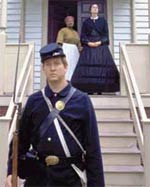
Mrs. C.B.T. Coleman, portrayed by Anne Marie Millar, and her servant, portrayed by Sandra Johnson, discover a Union sentry at the gate of Williamsburg's St. George Tucker House during a re-enactment. --Tom Green
Insurrections have three times thrust upon Williamsburg armies of occupation. In July 1676, when the town was yet called Middle Plantation, it fell into the power of the rebel Nathaniel Bacon and his men. In June 1781, as the war for American independence neared its dénouement, England's Lord Cornwallis and his troops briefly took over the city. After Yorktown, French troops took up winter residence. Eighty years later, the morning of May 6, 1862, in the War for Southern Independence the first of the Yankees marched in.
It was the end of the Battle of Williamsburg, a clash along an arc of earthen ramparts anchored by Fort Magruder just to the east of town. It was the second year of the national catastrophe of civil war.
A Federal Army commanded by General George B. McClellan was advancing on Richmond, the Confederate capital, and Williamsburg stood in the way. Union columns pushed through the city to pursue the main body of the retreating Southern troops. Thousands of dead and wounded soldiers from the North and from the South lay in and around the town, and another generation of Williamsburg's inhabitants were getting a closer look at what war means.
Confederate forces had been deployed across Virginia's Peninsula since soon after the state seceded in April 1861. At the Peninsula's tip stood Union-held Fort Monroe. As the months passed and the defending forces grew, Williamsburg had filled with sick soldiers. All the churches had been converted to infirmaries to take in those who could not be treated in the military hospitals at the Female Seminary and the College of William and Mary.
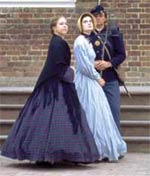
Two women of Civil War Williamsburg snub a bluecoat.
--Dave Doody
In the aftermath of battle, wounded soldiers from both armies were carried for treatment to private homes and the public greens. Casualties were everywhere. An observer at Bruton Parish Church wrote:
This church had been occupied as an hospital; the seats torn up, and beds, cots, and stretchers extended over the whole building; and across the floor in every direction had run streams of blood. Into this had been gathered . . . great numbers of the wounded and dying of the rebel army; outside the church on the grounds amidst the monuments and tents, the wounded had all been placed, and every spot was baptized with blood, and even on the white slabs were the traces of human suffering.
Then there were the conquering Federals. Mrs. Cynthia Beverley Tucker Coleman of the Tucker house on Market Square watched the victors trooping down Main Street, as the Duke of Gloucester Street was then known. A proud granddaughter of St. George Tucker and the wife of the assistant surgeon of a local Confederate cavalry unit, she wrote:
First in line comes the Artillery as fresh to all appearances and richly caparisoned as though no battle had been fought, no cannon taken the day before. Then follows the infantry in one unbroken line of twenty eight Regiments with bands of music playing Dixie, Yankee Doodle, Hail Columbia and John Brown's Body. They pass on up the Duke of Gloucester St. which in it's time has echoed to the tramp of Hessians, English, French, Continental troops, felt the noiseless foot-fall of the stealthy Indian. The Cavalry possess themselves of the Palace Green covered with it's golden shower of buttercups. Supply wagons camp upon the Courthouse Green. Indignant faces look out from behind closed blinds upon the desecration, as they feel it to be, of their beautiful old town.
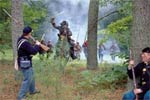
Re-enactment of the Battle of Williamsburg
--Tom Green
Few of the Federals stayed long. McClellan was pursuing the retreating Confederates in a chase that would end within two months in his defeat in the running battle outside Richmond known as the Seven Days. But some of his soldiers remembered Williamsburg well. One, Alfred Bellard, wrote of his regiment's passing through town: "We marched through the city, with bands playing and colors flying much to the disgust of the secesh women, one of whom said that she wished we would never get back."
A Federal provost marshal took over the vacated home of W. W. Vest at the east end of the city and imposed martial law. For the duration, Williamsburg remained within Union lines.
With its able-bodied men away fighting, it was a city of graybeards, young boys, and rebel women like Harriette Cary, 23, who wrote: "The repudiated Stars and Stripes are now waving over our Town, and humiliated I feel, we bow our heads to Yankee despotism. God grant our Southern Patriots may soon relieve us of this degrading yoke."
Williamsburg's women went out of their way to irritate the intruders. Captain Henry Blake of the U. S. Army said:
The women . . . took advantage of the uniform courtesy of the 'Yankees,' whom they despised and hated. . . . They compressed their dresses whenever they met an officer or enlisted man, so that the garments would not touch the persons they passed. They pulled their hats over their faces to preclude scrutiny. But these precautions were useless, for their cadaverous features and lank forms were sometimes seen; and all were satisfied that the Southern beauties about whom so much has been written did not reside in Williamsburg.
For more than three years, Federal troops would struggle with sometimes recalcitrant townspeople, Confederate guerilla raids, and the slavery question. The town's inhabitants would labor under what they considered a foreign occupation. The day-to-day traumas would affect Williamsburg until well into the 20th century. Early on, they precipitated a personal tragedy.
When Union troops entered Dr. John Minson Galt II was serving as the superintendent of the Eastern Lunatic Asylum and sharing the superintendent's quarters with his sister, Sarah "Sallie" Mariah Galt. It had been the Galt home for more than 20 years.
Galt family ties had been close, but one-by-one they had been severed by death. Brother Alexander Galt, Jr., died in his 20s before the war. Sister Elizabeth died in 1854 after a long illness. Their mother died in 1858. Only Sallie and John Galt remained. She devoted herself to caring for him and their household.

The Battle of Williamsburg engagement produced almost
4,000 casualties and turned the city into a hospital.
--Tom Green
Federal authorities, however, denied Dr. Galt further entry to the asylum. The emotional strain was too great. Within two weeks he was dead of an overdose of the opiate laudanum. With his passing, the provost required Sallie Galt to vacate the superintendent's quarters. She returned to the family house on Francis Street in the company of two faithful slaves and a friend. Her grief was overpowering. She wrote: "Pity my wretchedness. My darling brother was . . . all the world to me, and without him life to me is dark and dreary. I who have lived all my life in an atmosphere of love, now have no one to love, or to love me."
Some residents welcomed the occupation. Since late 1861, area slaves had been running to Union posts at Fort Monroe and Hampton. Once within the Federal lines they were classed as contraband of war and enjoyed the protection of Union troops. As the Yankees marched into Williamsburg, most of the remaining slaves left their masters.
Some, however, stayed-mostly the elderly, through loyalty to the families they served. Many of the free blacks and mulattos stayed simply because Williamsburg was their home. Whether free or slave, the arrival of Union soldiers opened many African-American eyes.
A young house servant, Eliza Baker, recalled her first encounter with the United States Army:
We were all afraid for Mrs. Whiting had told us that the Yankees were devils, with horns on their heads, and that they would make us all pull the artillery guns.
Mrs. Whiting said, 'Twarn't for you . . . people to rejoice, because the Yankees will make you pull the artillery and work hard.'
One day a man rode up and said to me, 'Hello, Sissy.' He asked me . . how I liked the Yankees. And I said, 'I don't know, Sir, I ain't seen none.'
He told me that he was one, and I said, 'You can't be, 'cause Mrs. Whiting told us the Yankees have horns.'
Then he asked me to take him to Mrs. Whiting, and he told her she shouldn't frighten us slaves about the Yankees. He asked her for a drink of water from her well, and he asked her did she have any strychnine in it? She said she wouldn't think of such a thing. But he made her get a dipper and bucket and two glasses, and he made her drink two glasses of the water before he would taste it. Then he went on.
At least one white citizen of the town was pleased that the Stars and Stripes were again waving over Williamsburg. Lawyer Lemuel Bowden had been one of the few residents who had supported the Union through the secession crisis. He left the city in 1861, but returned with the advancing Union army, and the Federal military government installed him as mayor.
He returned to his brick home on the Duke of Gloucester Street, but his mother refused to live with him or have anything to do with her "traitorous" son. She removed herself to a cottage in the backyard.
In the early morning hours of September 9, 1862, Confederate raiders galloped onto the grounds of William and Mary where they surprised a Union picket post, killed some Federal troops, and captured the remainder.
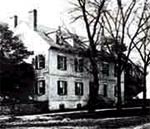
The home of W. W. Vest was headquarters for Confederate and Union forces. Today's Palmer House, it became the Federal Provost Marshal's office during the occupation.
--Will Molineux
The Southern cavalrymen raced down Main Street to the Vest House at the east end of town where they surprised the provost marshal himself, Colonel David Campbell of the 5th Pennsylvania Cavalry. Captured in his bed, Colonel Campbell was whisked away.
The raid lasted less than two hours, but embarrassed the occupying troops. Later that evening in retaliation, members of the 5th Pennsylvania, reportedly drunk, set fire to the Wren Building at the college. Witnesses said that the Federal troopers held their sabers out to prevent the women of the town from forming a bucket line in an attempt to douse the flames. The Wren would not be rebuilt until 1869.
The Emancipation Proclamation freed Southern slaves as 1862 turned into 1863 with New Year's. Susie Melton, a slave living near Williamsburg, long remembered what she called "that night of freedom." She was, she said, about ten when she heard that Abraham Lincoln was freeing the slaves. The word had come from a Union soldier.
It was winter, and cold that night, she said, but everyone readied themselves to go to the Union lines. They cared nothing for their white mistress. All that night they danced and sang outdoors, and started near daybreak for freedom. On their backs they carried blankets, clothes, pots and pans, and even chickens. And as the sun came up over the trees they all started to sing.
The proclamation, however, did not immediately free a single person in Williamsburg or anywhere else in Virginia. It liberated only those slaves living in rebel-held territory, where, of course, there was no one to enforce its provisions. It left slaves behind Union lines as it found them. Moreover, it specifically excluded Accomac, Northampton, Elizabeth City, York, Princess Anne, and Norfolk counties.
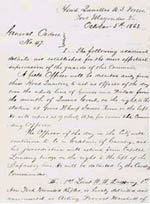
From Union headquarters at Fort Magruder, Yankee officers directed the
affairs of Williamsburg in dispatches and orders designed to keep order and enforce martial law.
A drunken Federal soldier killed the lieutenant appointed provost in this order, continued
below, about a week later at the Palmer House.
--Will Molineux
Williamsburg was under Federal control and half the city was in exempted York County. The validity of the proclamation within the city's limits was questionable, but evidence suggests the provost marshal liberally interpreted the decree and considered all the slaves in the area free.
In February 1863, the provost closed Bruton Parish Church because Rector Thomas M. Ambler refused to pray for the President of the United States. Perhaps in retaliation, Confederate troops attempted March 29 to retake Williamsburg.
Confederate infantry briefly entered the town, and skirmished with Federal cavalry on Main. Union Brigadier General Richard Busteed, in temporary command of the area, was convinced that the "rank traitors" in town were the cause of the attack.
After repulsing the Confederates, he reported: "The casualties were 5 wounded, 6 missing, and 2 murdered. The boots were stolen from off our dead. The enemy's loss . . . is at least 18. He came with a pair of wagons and four field pieces and was guided into the town by citizens of Williamsburg at three different points."
Busteed also issued an order that read, in part:
To provide against a repetition of the outrage the commanding General directs:
1st,-That all the privileges to all storekeepers in the City of Williamsburg and vicinity to purchase and sell goods are revoked.
2nd,-That all citizens who are willing to take the oath of allegiance to the Government of the United States will present themselves to the Provost Marshal of Williamsburg for the purpose of taking such oath on or before April 1st, 1863.
3rd,-That all citizens in the City of Williamsburg and vicinity who are not willing to take the oath of allegiance to the Government of the United States, excepting the servants and employees of the Eastern Lunatic Asylum of the State of Virginia, will prepare themselves and their families to be placed beyond the lines now occupied by the armed forces of the said Govt. by April 2nd, 1863.
At least one woman announced "I'll sign anything that will make life easier for my people." But most of Williamsburg's inhabitants had no intention of swearing an oath of allegiance to the United States.
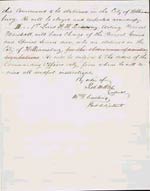
Busteed's superior, Major General Dix, countermanded the order within 24 hours, but imposed his own restrictions on the town. It contained these provisions:
1st-No persons will be allowed to go to Williamsburg from any point south of Fort Magruder without taking the oath of allegiance.
2nd-No citizen of Williamsburg will be permitted to go to Yorktown from any point south of Fort Magruder without taking the oath of allegiance.
3rd-No person will be allowed to trade in Williamsburg without taking the oath of allegiance.
Williamsburg was now sealed off, an island between the Union and Confederacy. Many families became dependent on the Federal commissary for their rations, issued every ten days. A market line was established on Mondays and Thursdays for farmers to bring their goods.
In April, the Confederates attacked again. Sallie Galt wrote:
We have been shelled twice in eleven days. They are not skirmishing in the streets today, the enemy are just at the end of Woodpecker street, & came in town this morning 290 of Infantry but seeing our cavalry at the College they made a precipitate retreat. . . . Numbers & numbers of our poor people are camping out in the woods, fearful of the rifle balls, which are flying about in the streets, & of another shelling which may be inflicted on us at any moment. . . . Only one shell struck the 'old house' & that did not injure it all. I was in the library when it struck, just under the window sill-a fragment of shell. I have never felt the first sensation of fear . . . & felt that if I was killed either by musket ball when they were fighting just at our door, or by shell, I should rejoin all I loved-, there is joy ineffable in the thought.
The news of Confederate victory at Chancellorsville was tempered by the report of the loss of General Thomas J. "Stonewall" Jackson. Throughout the month the women of Williamsburg wore mourning badges in remembrance of Jackson.
Towards the end of 1863, a young orderly of the 25th Massachusetts Volunteers, Sam Putnam, served on detached duty in Williamsburg and wrote to his father:
Most or rather a great many of the houses present the usual appearance of a captured town that is they look as if a "dose of salts had been through them" and they had been cleaned out. In one respect all Southern towns look alike, that air of neglect and decay hangs over them all, and Williamsburg is no exception.
Putnam contributed to the cleaning out of the town. His letter continued:
In a large house in town, near the headquarters of our section of our guard is a lot of books tumbled about promiscuously all over the floor of one room evidently the library. I have borrowed two or three to-read you know. In the attic of this house which is a quaint old building "of the olden time" is a large lot of old letters, from many distinguished persons of the revolutionary time. I send you some one or more from Thos Jefferson-The sage of Monticello-. . . . You may find the letters of interest, there are one or two for the girls as they can see how the revolutionary maidens used to correspond. I'll send them all when I can.
This house has been locked up since a day or two and we cannot go in again. The guard is very strict in town, no one being allowed to go in without a pass. . . . But I went in and borrowed a few books for all that I won't tell how. Ask me no questions and I'll tell you no lies.
Except for the irritating, ever-present Federal soldiers, 1864 was comparatively quiet, although great battles raged throughout Virginia. As the year ended, the hopes of a Confederate victory dimmed.
On February 11, 1865, a small party of Confederate raiders dashed into Williamsburg about 3 a.m., killed one Union soldier, wounded four others, and captured four more. The raiders were part of the command of Colonel John S. Mosby, who had been instructed to ascertain Federal activity or intentions on the Peninsula. After chasing off the picket guard on Richmond Road, the raiders disappeared before an effective Federal response could be organized. Except for causing a moment of commotion, the raid accomplished nothing.
With Confederate General Robert E. Lee's surrender and the Army of Northern Virginia at Appomattox in April, uneasy peace returned to Williamsburg.
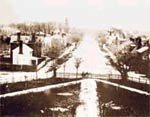
Colonial Williamsburg - This 1860 view of Williamsburg shows the Duke
of Gloucester Street, looking east from the College of William and Mary, on the eve of the war.
--Colonial Williamsburg
The Freedmen's Bureau established an office in town. Later, a Quaker mission from Philadelphia opened a school to teach former slaves to read and write. Although the shooting had stopped, Federal occupation continued. It would not be until September that the last Union soldiers would depart, allowing the city to take up its own governance again. Williamsburg, along with the rest of Virginia, became part of Military District Number One until January 26, 1870.
Refugees and veterans began to trickle back into town to begin the rebuilding of their lives. The people of Williamsburg had experienced war up close, with all its misery and suffering. Like Virginia and the rest of the South, The city mourned her dead and looked forward uncertainly to the future.
Carson Hudson is program production manager for Colonial Williamsburg's department of evening and special programs, and author of Civil War Williamsburg. Portions of this article come from his manuscript, Yankees in the Streets: The Life and Times of the Confederate Women of Williamsburg.
